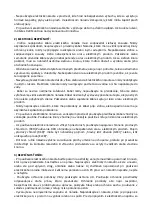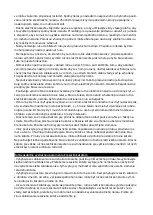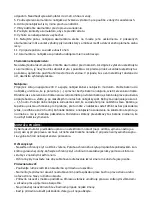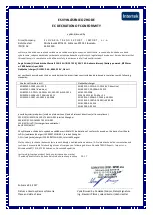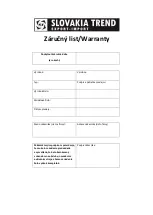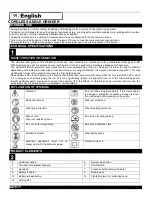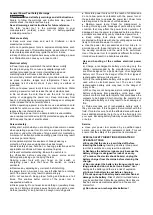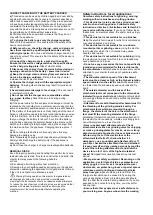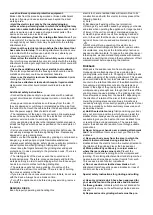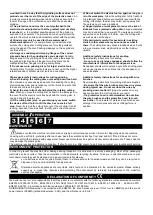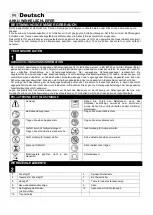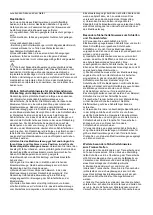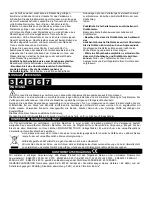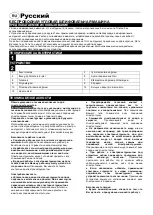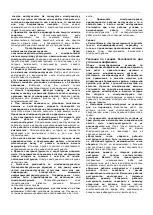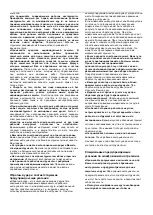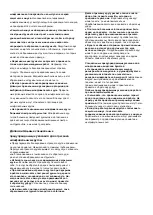
General Power Tool Safety Warnings
Read all safety warnings and all instructions.
Failure to follow the warnings and instructions may result in
electric shock, fire and/or serious injury.
Save all warnings and instructions for future reference.
The term “power tool” in the warnings refers to your
mainsoperated (corded) power tool or battery-operated
(cordless) power tool.
Work area safety
●
Keep work area clean and well lit. Cluttered or dark
areasinvite accidents.
●
Do not operate power tools in explosive atmospheres, such
as in the presence of flammable liquids, gases ordust. Power
tools create sparks which may ignite the dust or fumes.
●
Keep children and bystanders away while operating a power
tool. Distractions can cause you to lose control.
Electrical safety
●
Power tool plugs must match the outlet. Never modify
the plug in any way. Do not use any adapter plugs with
earthed (grounded) power tools. Unmodified plugs and
matching outlets will reduce risk of electric shock.
●
Avoid body contact with earthed or grounded surfaces, such
as pipes, radiators, ranges and refrigerators. There is an
increased risk of electric shock if your body is earthed or
grounded.
●
Do not expose power tools to rain or wet conditions. Water
entering a power tool will increase the risk of electric shock.
●
Do not abuse the cord. Never use the cord for carrying,
pulling or unplugging the power tool. Keep cord away from
heat, oil, sharp edges and moving parts. Damaged or entangled
cords increase the risk of electric shock.
●
When operating a power tool outdoors, use an extension cord
suitable for outdoor use. Use of a cord suitable for outdoor use
reduces the risk of electric shock.
●
If operating a power tool in a damp location is unavoidable,
use a residual current device (RCD) protected supply. Use of an
RCD reduces the risk of electric shock.
Personal safety
●
Stay alert, watch what you are doing and use common sense
when operating a power tool. Do not use a power tool while you
are tired or under the influence of drugs, alcohol or medication.
A moment of inattention while operating power tools may result
in serious personal injury.
●
Use personal protective equipment. Always wear eye
protection. Protective equipment such as dust mask,
non-skid safety shoes, hard hat, or hearing protection used for
appropriate conditions will reduce personal injuries.
●
Prevent unintentional starting. Ensure the switch is in
the off-position before connecting to power source and/or
battery pack, picking up or carrying the tool.
Carrying power tools with your finger on the switch or
energizing power tools that have the switch on invites
accidents.
●
Remove any adjusting key or wrench before turning
the power tool on. A wrench or a key left attached to a rotating
part of the power tool may result in personal injury.
●
Do not overreach. Keep proper footing and balance at all
times. This enables better control of the power tool in
unexpected situations.
●
Dress properly. Do not wear loose clothing or jewellery. Keep
your hair, clothing and gloves away from moving parts. Loose
clothes, jewellery or long hair can be caught in moving parts.
● Store idle power tools out of the reach of children and
do not allow persons unfamiliar with the power tool or
these instructions to operate the power tool. Power tools
are dangerous in the hands of untrained users.
● Maintain power tools. Check for misalignment or
binding of moving parts, breakage of parts and any other
condition that may affect the power tool’s operation. If
damaged, have the power tool repaired before use. Many
accidents are caused by poorly maintained power tools.
● Keep cutting tools sharp and clean. Properly
maintained cutting tools with sharp cutting edges are less
likely to bind and are easier to control.
● Use the power tool, accessories and tool bits etc. in
accordance with these instructions, taking into account
the working conditions and the work to be performed.
Use of the power tool for operations different from those
intended could result in a hazardous situation.
Use and handling of the cordless electrical power
tool
a) Charge a rechargeable battery unit using only the
charger recommended by the manufacturer. Chargers
are often designed for a particular type of rechargeable
battery unit. There is the danger of fire if other types of
rechargeable battery units are used.
b) Only the rechargeable battery units supplied are to be
used with an electrical power tool. The use of other
rechargeable battery units may lead to the danger of
injury or fire.
c) When they are not being used, store rechargeable
battery units away from paperclips, coins, keys, nails,
screws or other small metal objects that could cause the
contacts to be bridged. Short-circuiting the contacts of a
rechargeable battery unit may result in heat damage or
fire.
d) Fluids may leak out of rechargeable battery units if
they are misused. If this happens, avoid contact with the
fluid. If contact occurs, flush the affected area with water.
Seek additional medical help if any of the fluid gets into
your eyes. Escaping battery fluid may cause skin irritation
or burns.
Service
● Have your power tool serviced by a qualified repair
person using only identical replacement parts. This will
ensure that the safety of the power tool is maintained.
SPECIAL SAFETY DIRECTIONS FOR BATTERY-
OPERATED TOOLS
a) Ensure that the device is switched off before
inserting the battery.
Inserting a battery into a power
tool that is switched on may result in accidents.
b) Recharge the batteries indoors only because the
battery charger is designed for indoor use only.
c) To reduce the electric shock hazard, unplug the
battery charger from the mains before cleaning the
charger.
d) Do not subject the battery to strong sunlight over
long periods and do not leave it on a heater.
Heat
damages the battery and there is a risk of explosion.
e) Allow a hot battery to cool before charging.
f) Do not open up the battery and avoid mechanical
damage to the battery.
Risk of short circuit and fumes
may be emitted that irritate the respiratory tract. Ensure
fresh air and seek medical assistance in the event of
discomfort.
g) Do not use non-rechargeable batteries!

